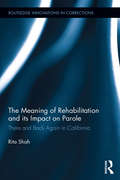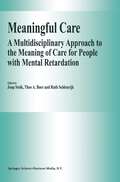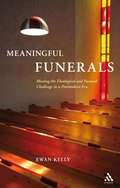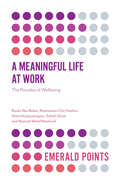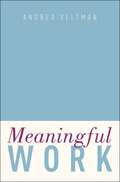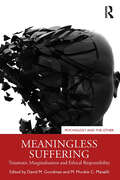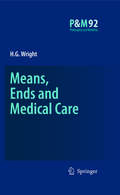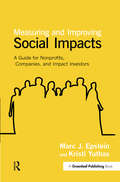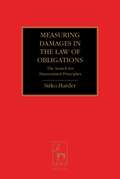- Table View
- List View
The Meaning of 'Ought': Beyond Descriptivism and Expressivism in Metaethics (Oxford Moral Theory)
by Matthew ChrismanThe word 'ought' is one of the core normative terms, but it is also a modal word. In this book Matthew Chrisman develops a careful account of the semantics of 'ought' as a modal operator, and uses this to motivate a novel inferentialist account of why ought-sentences have the meaning that they have. This is a metanormative account that agrees with traditional descriptivist theories in metaethics that specifying the truth-conditions of normative sentences is a central part of the explanation of their meaning. But Chrisman argues that this leaves important metasemantic questions about what it is in virtue of which ought-sentences have the meanings that they have unanswered. His appeal to inferentialism aims to provide a viable anti-descriptivist but also anti-expressivist answer to these questions. "This is a remarkably bold and interesting book. Chrisman challenges nothing less than the entire conceptual framework within which most previous metaethics (and indeed, much other contemporary philosophy) has been done, and advances a very ambitious rethinking of the theoretical space. It's not only ambitious, but also extremely imaginative and smart, and Chrisman's scholarship is at a rare level, as he has assimilated a literature that is unusually broad both in terms of field and historical scope."-Stephen Finlay, Professor of Philosophy, University of Southern California
The Meaning of Rehabilitation and its Impact on Parole: There and Back Again in California (Innovations in Corrections)
by Rita ShahThis book queries the concept of rehabilitation to determine how, on a legislative and policy level, the term is defined as a goal of correctional systems. The book explores what rehabilitation is by investigating how, at different moments in time, its conceptualization has shaped, and been shaped by, shifting norms, practices, and institutions of corrections in California. The author calls for a rethinking of theoretical understandings of the corrections system, generally, and parole system, specifically, and calls for an expansion in the questions asked in reintegration studies. The book is designed for scholars seeking to better understand the relationship between correctional systems and rehabilitation and the full scope of rehabilitation as a legislative goal, and is also suitable for use as teaching tool for historical, textual, and interviewing methods.
The Meaning of Rehabilitation and its Impact on Parole: There and Back Again in California (Innovations in Corrections)
by Rita ShahThis book queries the concept of rehabilitation to determine how, on a legislative and policy level, the term is defined as a goal of correctional systems. The book explores what rehabilitation is by investigating how, at different moments in time, its conceptualization has shaped, and been shaped by, shifting norms, practices, and institutions of corrections in California. The author calls for a rethinking of theoretical understandings of the corrections system, generally, and parole system, specifically, and calls for an expansion in the questions asked in reintegration studies. The book is designed for scholars seeking to better understand the relationship between correctional systems and rehabilitation and the full scope of rehabilitation as a legislative goal, and is also suitable for use as teaching tool for historical, textual, and interviewing methods.
Meaningful Care: A Multidisciplinary Approach to the Meaning of Care for People with Mental Retardation
by RuthSeldenrijk Theo A.Boer JoopStolkIt is crucial for the quality of care of people with mental retardation that care providers experience their work as meaningful. A complexity, however, is the fact that this care is divided amongst a range of professions. This book addresses issues of meaning (meaning of care and meaning of life) from all the different professional perspectives involved. Such a multidisciplinary approach is unique and has never before been followed. The book contains the results of a series of interviews in which parents of people with mental retardation were asked what they conceive to be meaningful care. The results are placed in relation to experiences and conceptions of professional caregivers. Moreover, the study analyzes the cultural, philosophical, and theological significance of the concept, `meaningful care'. Finally, the book explores the relevance of this concept for practical professions such as medical care, social work, educational psychology, pedagogic counseling, and pastoral care. Scholarly depth is combined with experiential knowledge of professional practice. Hence, this book is an outstanding source of reflection for all those who work professionally with people with mental retardation.
Meaningful Funerals: Meeting the Theological and Pastoral Challenge in a Postmodern Era
by Ewan KellyThe majority of the British population no longer attend church and, consequently, lack familiarity with the Christian tradition, its stories, language and metaphors. However, when bereaved, many still turn to church representatives, working in parish settings or chaplaincies, to perform funerals for their loved ones. The key issue addressed in this book is how funerals may be created which are not only relevant for the bereaved, but also have theological integrity. A paradigm shift in the manner by which funerals are constructed is proposed - from imposing alien liturgies to creating a unique ritual which evolves from the meeting of the stories of the bereaved and that of the ritual leader. The argument for the co-construction of funerals is informed by contemporary models of grief and Kelly's own experience with bereaved parents who worked with hospital chaplains to co-construct funerals for their babies. Co-construction is a process which is centred on listening and empowering, and involves offering the bereaved choices from a range of ritual resources (sacred and secular) in order to help them shape their funeral's content. It is a model of ritual construction which requires time, availability and risk-taking on the part of the ritual leader but which significantly helps the spiritual needs of the bereaved to be met. Moreover, such a process facilitates sensitive regulation of grief in an age where its privatisation has meant the bereaved are often bereft of a means by which to benchmark their feelings, behaviour and decision making.
A Meaningful Life at Work: The Paradox of Wellbeing (Emerald Points)
by Raida Abu Bakar Rosmawani Che Hashim Sharmila Jayasingam Safiah Omar Norizah Mohd MustamilA Meaningful Life at Work addresses a range of contemporary issues that impact on an individual's experiences in the workplace, including those that may restrict opportunities for personal growth in a professional setting. Understanding an employee's values, their choices and the problems they face in the workplace may help organisations to better structure their human resource policies, compensation packages and working conditions. The authors explore employee wellbeing from a Malaysian perspective as a developing country, but they also reflect on the broader Asian and wider global context. The key themes analysed in this book include work addiction, cyber bullying, sexual harassment in the workplace and the ethics of workplace behaviour. The book contributes to the theoretical discourse around organisation studies and employee wellbeing, while also seeking to integrate academic concepts with practice. In this way, it offers practical steps towards promoting positivity and happiness in the workplace.
A Meaningful Life at Work: The Paradox of Wellbeing (Emerald Points)
by Raida Abu Bakar Rosmawani Che Hashim Sharmila Jayasingam Safiah Omar Norizah Mohd MustamilA Meaningful Life at Work addresses a range of contemporary issues that impact on an individual's experiences in the workplace, including those that may restrict opportunities for personal growth in a professional setting. Understanding an employee's values, their choices and the problems they face in the workplace may help organisations to better structure their human resource policies, compensation packages and working conditions. The authors explore employee wellbeing from a Malaysian perspective as a developing country, but they also reflect on the broader Asian and wider global context. The key themes analysed in this book include work addiction, cyber bullying, sexual harassment in the workplace and the ethics of workplace behaviour. The book contributes to the theoretical discourse around organisation studies and employee wellbeing, while also seeking to integrate academic concepts with practice. In this way, it offers practical steps towards promoting positivity and happiness in the workplace.
Meaningful Work: Rethinking Professional Ethics (Practical and Professional Ethics)
by Mike W. MartinAs commonly understood, professional ethics consists of shared duties and episodic dilemmas--the responsibilities incumbent on all members of specific professions joined together with the dilemmas that arise when these responsibilities conflict. Martin challenges this "consensus paradigm" as he rethinks professional ethics to include personal commitments and ideals, of which many are not mandatory. Using specific examples from a wide range of professions, including medicine, law, high school teaching, journalism, engineering, and ministry, he explores how personal commitments motivate, guide, and give meaning to work.
Meaningful Work: Rethinking Professional Ethics (Practical and Professional Ethics)
by Mike W. MartinAs commonly understood, professional ethics consists of shared duties and episodic dilemmas--the responsibilities incumbent on all members of specific professions joined together with the dilemmas that arise when these responsibilities conflict. Martin challenges this "consensus paradigm" as he rethinks professional ethics to include personal commitments and ideals, of which many are not mandatory. Using specific examples from a wide range of professions, including medicine, law, high school teaching, journalism, engineering, and ministry, he explores how personal commitments motivate, guide, and give meaning to work.
Meaningful Work
by Andrea VeltmanThis book examines the importance of work in human well-being, addressing several related philosophical questions about work and arguing on the whole that meaningful work is central in human flourishing. Work impacts flourishing not only in developing and exercising human capabilities but also in instilling and reflecting virtues such as honor, pride, dignity, self-discipline and self-respect. Work also attaches to a sense of purposefulness and personal identity, and meaningful work can promote both personal autonomy and a sense of personal satisfaction that issues from making oneself useful. Further still, work bears a formative influence on character and intelligence and provides a primary avenue for exercising complex skills and garnering esteem and recognition from others. The author defends a pluralistic account of meaningful work, arguing that work can be meaningful in virtue of developing capabilities, supporting virtues, providing a purpose, or integrating elements of a worker's life. In light of the impact of meaningful work on living well, the author argues that well-ordered societies provide opportunities for meaningful work, that individuals would be well advised to pursue these opportunities, and that the philosophical view of value pluralism, which casts work as having no special significance in an individual's life, is false. The book also addresses oppressive work that undermines human flourishing, examining potential solutions to mitigate the impact of bad work on those who perform it. Finally, a guiding argument of the book is that promoting meaningful work is a matter of ethics, more so than a matter of politics. Prioritizing people over profit, treating workers with respect, respecting the intelligence of working people, and creating opportunities for people to contribute developed skills are basic ethical principles for employing organizations and for communities at large.
Meaningful Work
by Andrea VeltmanThis book examines the importance of work in human well-being, addressing several related philosophical questions about work and arguing on the whole that meaningful work is central in human flourishing. Work impacts flourishing not only in developing and exercising human capabilities but also in instilling and reflecting virtues such as honor, pride, dignity, self-discipline and self-respect. Work also attaches to a sense of purposefulness and personal identity, and meaningful work can promote both personal autonomy and a sense of personal satisfaction that issues from making oneself useful. Further still, work bears a formative influence on character and intelligence and provides a primary avenue for exercising complex skills and garnering esteem and recognition from others. The author defends a pluralistic account of meaningful work, arguing that work can be meaningful in virtue of developing capabilities, supporting virtues, providing a purpose, or integrating elements of a worker's life. In light of the impact of meaningful work on living well, the author argues that well-ordered societies provide opportunities for meaningful work, that individuals would be well advised to pursue these opportunities, and that the philosophical view of value pluralism, which casts work as having no special significance in an individual's life, is false. The book also addresses oppressive work that undermines human flourishing, examining potential solutions to mitigate the impact of bad work on those who perform it. Finally, a guiding argument of the book is that promoting meaningful work is a matter of ethics, more so than a matter of politics. Prioritizing people over profit, treating workers with respect, respecting the intelligence of working people, and creating opportunities for people to contribute developed skills are basic ethical principles for employing organizations and for communities at large.
Meaningless Suffering: Traumatic Marginalisation and Ethical Responsibility (Psychology and the Other)
by David M. Goodman M. Mookie C. ManaliliDoes suffering have meaning? The leading scholars and practitioners in Meaningless Suffering engage with this haunting human question through the lenses of psychoanalytic, phenomenological and ethical discourse, all the while holding contemporary social concerns in full view. The authors seek to find ways of speaking about the lived realities and historical moments that make up our social narratives – from the murder of George Floyd to the bird watching incident in Central Park – in order to render visible the entangled forms of the effects of embodiment, ideology, race, social practice, and intersectionality. Meaningless Suffering is bookended by powerful pieces by Mari Ruti and Homi K. Bhabha and, in the intervening chapters, the reader traverses the ideas of Augustine, Judith Butler, Fanon, Foucault, Freud, Gendlin, Heidegger, Lacan, Levinas, and Wittgenstein to pass through the realms of classical thought, affect theory, phenomenology, linguistic studies, relational psychoanalysis, somatic studies, intersubjectivity theory, gender studies, critical theory, and philosophical hermeneutics. This book is essential reading for postgraduate students, scholars, and practitioners working at the intersection of psychoanalysis, race, politics, and culture, as well as students of cultural studies, the humanities, politics, psychology, psychosocial studies, sociology, and social work.
Meaningless Suffering: Traumatic Marginalisation and Ethical Responsibility (Psychology and the Other)
Does suffering have meaning? The leading scholars and practitioners in Meaningless Suffering engage with this haunting human question through the lenses of psychoanalytic, phenomenological and ethical discourse, all the while holding contemporary social concerns in full view. The authors seek to find ways of speaking about the lived realities and historical moments that make up our social narratives – from the murder of George Floyd to the bird watching incident in Central Park – in order to render visible the entangled forms of the effects of embodiment, ideology, race, social practice, and intersectionality. Meaningless Suffering is bookended by powerful pieces by Mari Ruti and Homi K. Bhabha and, in the intervening chapters, the reader traverses the ideas of Augustine, Judith Butler, Fanon, Foucault, Freud, Gendlin, Heidegger, Lacan, Levinas, and Wittgenstein to pass through the realms of classical thought, affect theory, phenomenology, linguistic studies, relational psychoanalysis, somatic studies, intersubjectivity theory, gender studies, critical theory, and philosophical hermeneutics. This book is essential reading for postgraduate students, scholars, and practitioners working at the intersection of psychoanalysis, race, politics, and culture, as well as students of cultural studies, the humanities, politics, psychology, psychosocial studies, sociology, and social work.
Means, Ends and Medical Care (Philosophy and Medicine #92)
by H.G. WrightIn this remarkable book, Gary Wright focuses thirty years’ experience as a family physician, and his Ph.D. in philosophy, to address the nature of good medical reasoning. Wright folds cognitive science into a pragmatist framework developed by John Dewey; this alternative view of mind and medical judgment leads to a model of reasoning that offers realistic guidance for medical decisions, one that each of us would want our own physicians to adopt.
Means, Ends, and Persons: The Meaning and Psychological Dimensions of Kant's Humanity Formula
by Robert AudiNo one wants to be treated merely as a means-"used," in a sense. But just what is this repugnant treatment? Audi's point of departure is Kant's famous principle that we must treat persons as ends in themselves and never merely as means. Treatment of these kinds is conduct, a complex three-dimensional notion whose central elements are action, its motivation, and the manner of its performance. He shows how the notions of treating persons as ends and, by contrast, merely as means, can be anchored outside Kant and clarified in ways that enhance their usefulness both in ethical theory and in practical ethics, where they have much intuitive force. Audi constructs an account of treatment of persons-of what it is, how it differs from mere interpersonal action, and what ethical standards govern it. In accounting for such treatment, the book develops a wider conception of ethics than is commonly implicit in utilitarian, deontological, or virtue theories. These results contribute to ethical theory, but in its discussion of diverse narrative examples of moral and immoral conduct, the book also contributes to normative ethics. Audi's theory of conduct takes account of motivational elements that are not traits of character and of behavioral elements that are not manifestations of virtue or vice. Here it goes beyond the leading virtue approaches. The theory also advances rule ethics by framing wider conception of moral behavior-roughly, of acting morally. The results advance both normative ethics and ethical theory. For moral philosophy, the book frames conceptions, articulates distinctions, and formulates principles; and for practical ethics, it provides a multitude of cases that illustrate both the scope of moral responsibility and the normative standards for living up to it.
Means of Transportation and Registration of Nationality: Transportation Registered by International Organizations (Routledge Research in International Law)
by Vincent P. Cogliati-BantzThis book examines the concept of nationality of means of transportation in terms of jurisdiction in international law. It reassesses the definition of nationality and explores how it is conferred. The book first places nationality in the broader perspective of jurisdiction in international law, and examines the historical development and necessity of the nationality of means of transportation. It goes on to investigate whether and under which conditions international organizations may confer a ‘nationality’ on means of transportation, examining the law of the sea conventions and air and space treaties. The book finally explores several questions relating to international registration of means of transportation, building a regime of international registration. Vincent Cogliati-Bantz introduces a necessary distinction between transport internationally registered and transport registered in a State but fulfilling a mission for an international organization. As a work that proposes the ability for international organisations to access international spaces without reliance on State-registered means of transport, this book will be of great use and interest to scholars and students of public international law, international organisations, and maritime, space, and aviation law.
Means of Transportation and Registration of Nationality: Transportation Registered by International Organizations (Routledge Research in International Law)
by Vincent P. Cogliati-BantzThis book examines the concept of nationality of means of transportation in terms of jurisdiction in international law. It reassesses the definition of nationality and explores how it is conferred. The book first places nationality in the broader perspective of jurisdiction in international law, and examines the historical development and necessity of the nationality of means of transportation. It goes on to investigate whether and under which conditions international organizations may confer a ‘nationality’ on means of transportation, examining the law of the sea conventions and air and space treaties. The book finally explores several questions relating to international registration of means of transportation, building a regime of international registration. Vincent Cogliati-Bantz introduces a necessary distinction between transport internationally registered and transport registered in a State but fulfilling a mission for an international organization. As a work that proposes the ability for international organisations to access international spaces without reliance on State-registered means of transport, this book will be of great use and interest to scholars and students of public international law, international organisations, and maritime, space, and aviation law.
Measurement Uncertainty in Forensic Science: A Practical Guide
by Suzanne BellIn the courtroom, critical and life-changing decisions are made based on quantitative forensic science data. There is often a range in which a measured value is expected to fall and, in this, an inherent uncertainty associated with such measurement. Uncertainty in this context is not error. In fact, estimations of uncertainty can add to the utility and reliability of quantitative results, be it the length of a firearm barrel, the weight of a drug sample, or the concentration of ethanol in blood. Measurement Uncertainty in Forensic Science: A Practical Guide describes and defines the concepts related to such uncertainty in the forensic context. The book provides the necessary conceptual background and framework—a baseline—for developing and deploying reasonable and defensible uncertainty estimations across forensic disciplines. Information is presented conceptually, using easily understood examples, to provide a readable, handy reference for scientists in the laboratory, as well as investigators and legal professionals who require a basic understanding of the science underpinning measurement results.
Measurement Uncertainty in Forensic Science: A Practical Guide
by Suzanne BellIn the courtroom, critical and life-changing decisions are made based on quantitative forensic science data. There is often a range in which a measured value is expected to fall and, in this, an inherent uncertainty associated with such measurement. Uncertainty in this context is not error. In fact, estimations of uncertainty can add to the utility and reliability of quantitative results, be it the length of a firearm barrel, the weight of a drug sample, or the concentration of ethanol in blood. Measurement Uncertainty in Forensic Science: A Practical Guide describes and defines the concepts related to such uncertainty in the forensic context. The book provides the necessary conceptual background and framework—a baseline—for developing and deploying reasonable and defensible uncertainty estimations across forensic disciplines. Information is presented conceptually, using easily understood examples, to provide a readable, handy reference for scientists in the laboratory, as well as investigators and legal professionals who require a basic understanding of the science underpinning measurement results.
Measuring and Improving Social Impacts: A Guide for Nonprofits, Companies and Impact Investors
by Marc J. Epstein Kristi YuthasIdentifying, measuring and improving social impact is a significant challenge for corporate and private foundations, charities, NGOs and corporations. How best to balance possible social and environmental benefits (and costs) against one another? How does one bring clarity to multiple possibilities and opportunities? Based on years of work and new field studies from around the globe, the authors have written a book for managers that is grounded in the best academic and managerial research.It is a practical guide that describes the steps needed for identifying, measuring and improving social impact. This approach is useful in maximizing the impact of different types of investments, including grants and donations, impact investments, and commercial investments.With numerous examples of actual organizational approaches, research into more than fifty organizations, and extensive practical guidance and best practices, Measuring and Improving Social Impacts fills a critical gap.
Measuring and Improving Social Impacts: A Guide for Nonprofits, Companies and Impact Investors
by Marc J. Epstein Kristi YuthasIdentifying, measuring and improving social impact is a significant challenge for corporate and private foundations, charities, NGOs and corporations. How best to balance possible social and environmental benefits (and costs) against one another? How does one bring clarity to multiple possibilities and opportunities? Based on years of work and new field studies from around the globe, the authors have written a book for managers that is grounded in the best academic and managerial research.It is a practical guide that describes the steps needed for identifying, measuring and improving social impact. This approach is useful in maximizing the impact of different types of investments, including grants and donations, impact investments, and commercial investments.With numerous examples of actual organizational approaches, research into more than fifty organizations, and extensive practical guidance and best practices, Measuring and Improving Social Impacts fills a critical gap.
Measuring and Monitoring Children’s Well-Being (Social Indicators Research Series #7)
by Asher Ben-Arieh Natalie Hevener Kaufman Arlene Bowers Andrews Robert M. George Bong Joo Lee L. J. AberToday, any regular newspaper reader is likely to be exposed to reports on manifold forms of (physical, emotional, sexual) child abuse on the one hand, and abnormal behavior, misconduct or offences of children and minors on the other hand. Occasionally reports on children as victims and children as offenders may appear on the same issue or even the same page. Rather seldom the more complex and largely hidden phenomena of structural hostility or indifference of society with a view to children are being dealt with in the press. Such fragmentary, ambiguous, incoherent or even contradictory perception of children in modem society indicates that, firstly, there is a lack of reliable information on modem childhood, and secondly, children are still treated as a comparatively irrelevant population group in society. This conclusion may be surprising in particular when drawn at the end of The Century of the Child proclaimed by Ellen Key as early as 1902. Actually, there exist unclarities and ambiguities about the evolution of childhood in the last century not only in public opinion, but also in scientific literature. While De Mause with his psycho-historic model of the evolution of childhood, comprising different stages from infanticide, abandonment, ambivalence, intrusion, socialisation to support, underlines the continuous improvement of the condition of childhood throughout history and thus rather confirms Key's expectations, Aries, with his social history of childhood, seems to hold a more culturally pessimistic view.
Measuring Crime: Behind the Statistics (ASA-CRC Series on Statistical Reasoning in Science and Society)
by Sharon L. LohrCrime statistics are everywhere, but how do you know when they’re valid? If a newspaper report says "the rate of overall violent crime decreased by 0.9 percent," how can you tell where that statistic came from, what it measures, and how accurate it is? Is it worth repeating or sharing? Measuring Crime: Behind the Statistics gives you the tools to interpret and evaluate crime statistics’ quality and usefulness. The book focuses on ways of thinking about crime statistics (no formulas!) and features Eight questions you should ask before quoting a statistic The two sources of information about homicide FBI statistics: what do they measure? How victimization surveys can reflect your experiences even though you were not asked to participate Special considerations when interpreting statistics about sexual assault and fraud Examples of experiments and studies on how to improve crime statistics Two online supplements containing additional details and links to data sources Whether you are a law enforcement professional, journalist, student, or interested citizen, Measuring Crime: Behind the Statistics will tell you how to read statistics as a statistician would. Sharon Lohr, the author of Sampling: Design and Analysis, has published widely about statistical methods for education, public policy, law, and crime. She has been recognized as Fellow of the American Statistical Association, elected member of the International Statistical Institute, and recipient of the Gertrude M. Cox Statistics Award and the Deming Lecturer Award. Formerly Dean’s Distinguished Professor of Statistics at Arizona State University and a Vice President at Westat, she is now a freelance statistical consultant and writer. Visit her website at www.sharonlohr.com. "The book aims to achieve two goals: introduce statistical ideas to a general audience and provide an overview of US crime statistics. These are disparate topics, but in the way they are approached here, there is a strong synergy that reinforces both aspects. One the one hand, the reader's natural curiosity about crime (what is it, how are crime events classified and reported, how reliable are the numbers you see in the newspaper, etc.) will help him/her become interested in the statistical issues and learn these concepts in a practical and concrete setting. And on the other hand, by reading about the statistical issues surrounding crime data, he/she gains a better appreciation for the complexities of crime statistics, eventually acquiring a deeper understanding of them. As a statistician myself, I learned interesting facts about the types of crime, their nomenclature and the possible confusion surrounding them, and how the data are collected and reported. Overall, I think the combination is effective and very well developed in this book." (Jean Opsomer, Westat) "This book is an excellent primer on handling the mass of data and information researchers are faced with. While it is geared toward followers of criminal justice information, much of the book is a very good introduction to survey techniques discussing their strong and weak points. Most importantly, there are very good guidelines and questions that one should employ before citing any data or using data for policy decisions or for reporting on data such as journalists do. The book is written in a non-technical manner and does a very good job of explaining the nuances in reviewing data. Any researcher who utilizes data would find this valuable. While it has specific examples in the criminal justice field, it really is quite useful for any user of data." (Barry Nussbaum, former President American Statistical Association)
Measuring Crime: Behind the Statistics (ASA-CRC Series on Statistical Reasoning in Science and Society)
by Sharon L. LohrCrime statistics are everywhere, but how do you know when they’re valid? If a newspaper report says "the rate of overall violent crime decreased by 0.9 percent," how can you tell where that statistic came from, what it measures, and how accurate it is? Is it worth repeating or sharing? Measuring Crime: Behind the Statistics gives you the tools to interpret and evaluate crime statistics’ quality and usefulness. The book focuses on ways of thinking about crime statistics (no formulas!) and features Eight questions you should ask before quoting a statistic The two sources of information about homicide FBI statistics: what do they measure? How victimization surveys can reflect your experiences even though you were not asked to participate Special considerations when interpreting statistics about sexual assault and fraud Examples of experiments and studies on how to improve crime statistics Two online supplements containing additional details and links to data sources Whether you are a law enforcement professional, journalist, student, or interested citizen, Measuring Crime: Behind the Statistics will tell you how to read statistics as a statistician would. Sharon Lohr, the author of Sampling: Design and Analysis, has published widely about statistical methods for education, public policy, law, and crime. She has been recognized as Fellow of the American Statistical Association, elected member of the International Statistical Institute, and recipient of the Gertrude M. Cox Statistics Award and the Deming Lecturer Award. Formerly Dean’s Distinguished Professor of Statistics at Arizona State University and a Vice President at Westat, she is now a freelance statistical consultant and writer. Visit her website at www.sharonlohr.com. "The book aims to achieve two goals: introduce statistical ideas to a general audience and provide an overview of US crime statistics. These are disparate topics, but in the way they are approached here, there is a strong synergy that reinforces both aspects. One the one hand, the reader's natural curiosity about crime (what is it, how are crime events classified and reported, how reliable are the numbers you see in the newspaper, etc.) will help him/her become interested in the statistical issues and learn these concepts in a practical and concrete setting. And on the other hand, by reading about the statistical issues surrounding crime data, he/she gains a better appreciation for the complexities of crime statistics, eventually acquiring a deeper understanding of them. As a statistician myself, I learned interesting facts about the types of crime, their nomenclature and the possible confusion surrounding them, and how the data are collected and reported. Overall, I think the combination is effective and very well developed in this book." (Jean Opsomer, Westat) "This book is an excellent primer on handling the mass of data and information researchers are faced with. While it is geared toward followers of criminal justice information, much of the book is a very good introduction to survey techniques discussing their strong and weak points. Most importantly, there are very good guidelines and questions that one should employ before citing any data or using data for policy decisions or for reporting on data such as journalists do. The book is written in a non-technical manner and does a very good job of explaining the nuances in reviewing data. Any researcher who utilizes data would find this valuable. While it has specific examples in the criminal justice field, it really is quite useful for any user of data." (Barry Nussbaum, former President American Statistical Association)
Measuring Damages in the Law of Obligations: The Search for Harmonised Principles
by Sirko HarderThis book challenges certain differences between contract, tort and equity in relation to the measure (in a broad sense) of damages. Damages are defined as the monetary award made by a court in consequence of a breach of contract, a tort or an equitable wrong. In all these causes of action, damages usually aim to put the claimant into the position the claimant would be in without the wrong. Even though the main objective of damages is thus the same for each cause of action, their measure is not.While some aspects of the measure of damages are more or less harmonised between contract, tort and equity (e.g. causation in fact and mitigation), significant differences exist in relation to (1) remoteness of damage, which is the question of whether, when and to which degree damage needs to be foreseeable to be recoverable;(2) the compensability of non-pecuniary loss such as pain and suffering, distress and loss of reputation;(3) the effect of contributory negligence, which is the victim's contribution to the occurrence of the wrong or the ensuing loss through unreasonable conduct prior to the wrong;(4) the circumstances under which victims of wrongs can claim the gain the wrongdoer has made from the wrong; and(5) the availability and scope of exemplary (or punitive) damages.For each of the five topics, this book examines the present position in contract, tort and equity and establishes the differences between the three areas. It goes on to scrutinise the arguments in defence of existing differences. The conclusion on each topic is that the present differences between contract, tort and equity cannot be justified on merits and should be removed through a harmonisation of the relevant principles.

